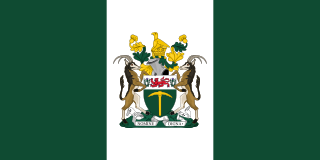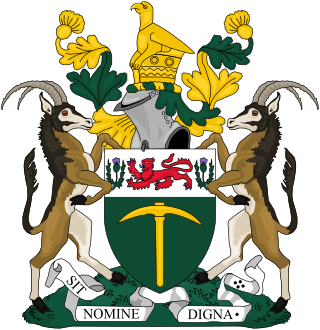
Rhodesia, officially from 1970 the Republic of Rhodesia, was an unrecognised state in Southern Africa from 1965 to 1979, equivalent in territory to modern Zimbabwe. Rhodesia was the de facto successor state to the British colony of Southern Rhodesia, which had been self-governing since achieving responsible government in 1923. A landlocked nation, Rhodesia was bordered by South Africa to the south, Bechuanaland to the southwest, Zambia to the northwest, and Mozambique to the east. From 1965 to 1979, Rhodesia was one of two independent states on the African continent governed by a white minority of European descent and culture, the other being South Africa.

Northern Rhodesia was a British protectorate in south central Africa, now the independent country of Zambia. It was formed in 1911 by amalgamating the two earlier protectorates of Barotziland-North-Western Rhodesia and North-Eastern Rhodesia. It was initially administered, as were the two earlier protectorates, by the British South Africa Company (BSAC), a chartered company, on behalf of the British Government. From 1924, it was administered by the British Government as a protectorate, under similar conditions to other British-administered protectorates, and the special provisions required when it was administered by BSAC were terminated.

Southern Rhodesia was a landlocked self-governing British Crown colony in southern Africa, established in 1923 and consisting of British South Africa Company (BSAC) territories lying south of the Zambezi River. The region was informally known as south Zambesia until annexed by Britain at the behest of Cecil Rhodes's British South Africa Company, for whom the colony was named. The bounding territories were Bechuanaland (Botswana), Northern Rhodesia (Zambia), Moçambique (Mozambique), and the Transvaal Republic.

The British South Africa Company was chartered in 1889 following the amalgamation of Cecil Rhodes' Central Search Association and the London-based Exploring Company Ltd, which had originally competed to capitalize on the expected mineral wealth of Mashonaland but united because of common economic interests and to secure British government backing. The company received a Royal Charter modelled on that of the British East India Company. Its first directors included The 2nd Duke of Abercorn, Rhodes himself, and the South African financier Alfred Beit. Rhodes hoped BSAC would promote colonisation and economic exploitation across much of south-central Africa, as part of the "Scramble for Africa". However, his main focus was south of the Zambezi, in Mashonaland and the coastal areas to its east, from which he believed the Portuguese could be removed by payment or force, and in the Transvaal, which he hoped would return to British control.

Rhodesia, known initially as Zambesia, is a historical region in southern Africa whose formal boundaries evolved between the 1890s and 1980. Demarcated and named by the British South Africa Company (BSAC), which governed it until the 1920s, it thereafter saw administration by various authorities. It was bisected by a natural border, the Zambezi. The territory to the north of the Zambezi was officially designated Northern Rhodesia by the company, and has been Zambia since 1964; that to the south, which the company dubbed Southern Rhodesia, became Zimbabwe in 1980. Northern and Southern Rhodesia were sometimes informally called "the Rhodesias".

Sir Charles Patrick John Coghlan,, was a lawyer and politician who served as Premier of Southern Rhodesia from 1 October 1923 to his death. Having led the responsible government movement in the territory during the latter days of Company rule, he was Southern Rhodesia's first head of government after it became a self-governing colony within the British Empire.

The Governor of Southern Rhodesia was the representative of the British monarch in the self-governing colony of Southern Rhodesia from 1923 to 1980. The Governor was appointed by The Crown and acted as the local head of state, receiving instructions from the British Government.

The Parliament of Zimbabwe is the bicameral legislature of Zimbabwe composed of the Senate and the National Assembly. The Senate is the upper house, and consists of 80 members, 60 of whom are elected by proportional representation from ten six-member constituencies corresponding to the country's provinces. Of the remaining 20 seats, 18 are reserved for chiefs, and two for people with disabilities. The National Assembly is the lower house, and consists of 280 members. Of these, 210 are elected from single-member constituencies. The remaining 70 seats are reserved women's and youth quotas: 60 for women; 10 for youth. These are elected by proportional representation from ten six-member and one-member constituencies respectively, corresponding to the country's provinces.

Elections in Southern Rhodesia were used from 1899 to 1923 to elect part of the Legislative Council and from 1924 to elect the whole of the Legislative Assembly which governed the colony. Since the granting of self-government in 1923, Southern Rhodesia used the Westminster parliamentary system as its basis of government. The Political party that had most of the seats in the Legislative Assembly became the government. The person in charge of this bloc was the Premier, later renamed Prime Minister, who then chose his cabinet from his elected colleagues.
Legislative Council elections were held in Southern Rhodesia on 17 April 1899. They were the first elections to take place in the colony and followed the Southern Rhodesia Order in Council of 1898 which granted the colony a Legislative Council consisting of at least ten voting members: the Administrator of Southern Rhodesia ex officio, five members nominated by the British South Africa Company, and four members elected by registered voters. The Resident Commissioner of Southern Rhodesia, Sir Marshal James Clarke, also sat on the Legislative Council ex officio but without the right to vote.
The Southern Rhodesia Legislative Council election of April 24, 1908 was the fourth election to the Legislative Council of Southern Rhodesia. The Legislative Council had, since 1903, comprised seven members elected by registered voters from four electoral districts; in 1907 the number of members nominated by the British South Africa Company was reduced from seven to five. The Administrator of Southern Rhodesia sat on the Legislative Council ex officio. The Resident Commissioner of Southern Rhodesia, James George Fair, also sat on the Legislative Council ex officio but without the right to vote.
The Southern Rhodesia Legislative Council election of 18 March 1914 was the sixth election to the Legislative Council of Southern Rhodesia. The Legislative Council had resolved in 1913 that it should have twelve elected members, together with six members nominated by the British South Africa Company, and the Administrator of Southern Rhodesia. The Resident Commissioner of Southern Rhodesia also sat on the Legislative Council ex officio but without the right to vote. This office was first held by Robert Burns-Begg, from 1 April 1915 by Herbert James Stanley, and from 1 April 1918 by Crawford Douglas Douglas-Jones.
The colonial history of Southern Rhodesia is considered to be a time period from the British government's establishment of the government of Southern Rhodesia on 1 October 1923, to Prime Minister Ian Smith's unilateral declaration of independence in 1965. The territory of 'Southern Rhodesia' was originally referred to as 'South Zambezia' but the name 'Rhodesia' came into use in 1895. The designation 'Southern' was adopted in 1901 and dropped from normal usage in 1964 on the break-up of the Federation of Rhodesia and Nyasaland, and Rhodesia became the name of the country until the creation of Zimbabwe Rhodesia in 1979. Legally, from the British perspective, the name Southern Rhodesia continued to be used until 18 April 1980, when the name Republic of Zimbabwe was formally proclaimed.

The Legislative Assembly of Rhodesia was the legislature of Southern Rhodesia and then Rhodesia from 1924 to 1970.
Europeans first came to the region in southern Africa today called Zimbabwe in the sixteenth century, when Portuguese colonials ventured inland from Mozambique and attacked the Kingdom of Mutapa, which then controlled an area roughly equivalent to eastern Zimbabwe and western Mozambique. Portuguese influence over Mutapa endured for about two centuries before fading away during the 1690s and early-1700s (decade). During the year of 1685, French Huguenots emigrated to present-day South Africa and whilst some settled there, others moved further north into the continent. Those who did, settled within modern-day Zimbabwe, Mozambique and Botswana, and co-existed with the indigenous people; most of whom, in Zimbabwe, were the Naletale people.

Zimbabwe and the Commonwealth of Nations have had a controversial and stormy diplomatic relationship. Zimbabwe is a former member of the Commonwealth, having withdrawn in 2003, and the issue of Zimbabwe has repeatedly taken centre stage in the Commonwealth, both since Zimbabwe's independence and as part of the British Empire.

The modern political history of Zimbabwe starts with the arrival of white people to what was dubbed Southern Rhodesia in the 1890s. The country was initially run by an administrator appointed by the British South Africa Company. The prime ministerial role was first created in October 1923, when the country achieved responsible government, with Sir Charles Coghlan as its first Premier. The third Premier, George Mitchell, renamed the post Prime Minister in 1933.

Advisory Council elections were held in Northern Rhodesia for the first time in July 1918.

The flag of the British South Africa Company was the flag used by the British South Africa Company (BSAC) and Rhodesia under company rule. It was adopted in 1892 and was used until 1923 when the south of Rhodesia voted to become Southern Rhodesia and the north was surrendered to the Colonial Office to become Northern Rhodesia. The flag remained as the company's commercial flag until 1965. The flag consisted of a British Union Flag with the company's logo of a lion and tusk on a white circle in the centre with "B.S.A.C." underneath it.













